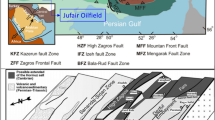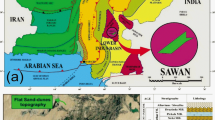Abstract
Today, researchers face multiple challenges identifying clay mineral types and lithofacies from well log data. This research paper hopes to offer new insight into this particular challenge. Formation evaluation characteristics play a significant role in the exploration and production of future and current oil and gas fields. The proposed methodology in this study uses an integrated approach that includes: (1) numerical equations, (2) Neuro-Fuzzy neural networks, (3) cross plots, and (4) statistical analyses. This proposed integrated approach is capable of dramatically improving the accuracy of the results. Well logging data provide valuable information for identifying lithofacies, clay mineralogy types, as well as other important hydrocarbon reservoir characteristics. Talhar Shale in the Southern Lower Indus Basin, Pakistan, is composed of interbedded shale, sand, and shaly-sand, intervals that have been identified via the lithological interpretation process of well logs. Talhar Shale contains montmorillonite type clay with minor amounts of illite, glauconite, and various micas that can be easily identified by natural gamma ray absorption profiles, as well as through ratio logs, bulk density log, and photoelectric absorption index log. These interpretations can be further confirmed via cross plots and other statistical analyses. This approach consists of a comprehensive study of well logging data and thus can lend itself to be a helpful component in characterizing the hydrocarbon structures of the Talhar Shale.










Similar content being viewed by others
References
Adams J A S and Gasparini P 1970 Gamma-ray spectrometry of rocks (1st edn) Elsevier Publ. Co., Amsterdam, New York.
Ali J 1994 Neural networks: A new tool for the petroleum industry?; In: European Petroleum Computer Conference, 15–17 March, 1994, Aberdeen, United Kingdom.
Aly S A, El-Sayed A M and El-Shawadfy A 2003 Application of well logs to assess the effect of clay minerals on the petrophysical parameters of lower cretaceous reservoirs north Sinai Egypt; Egypt Geophys. Soc. J. 1(1) 117–127.
Asquith G B, Krygowski D and Gibson C R 2004 Basic well log analysis (2nd edn), American Association of Petroleum Geologists, Tulsa.
Bigelow Ed L 1992 Introduction to Wireline Log Analysis; Houston, Texas: Western Atlas International.
Bosch D, Ledo J and Queralt P 2013 Fuzzy logic determination of lithologies from well log data: Application to the KTB project data set (Germany); Surv. Geophys. 34 413–439.
Chitale D V, Coates G R, Day P I and Sigal R F 2003 System and method for clay typing using NMR-based porosity modeling; USOO6646437B1 Google Patents.
Clark S P, Peterman Z E and Heier K S 1966 Section 24: Abundances of Uranium, Thorium, and Potassium; Geol. Soc. Am. Memoir 97 521–542.
Coates G R, Xiao L and Prammer M G 1999 NMR logging: Principles and applications; Halliburton Energy Services Publication, United States of America.
Dewan J T 1983 Essentials of modern open-hole log interpretation; PennWell Books, Tulsa, Oklahoma.
Doveton J 1991 Lithofacies and geochemical facies profiles from nuclear wireline logs: New subsurface templates for sedimentary modelling. Sedimentary modelling-computer simulations and methods for improved parameter definition; KGS Bull. 233 101–110.
Ellis D, Howard J, Flaum C, McKeon D, Scott H, Serra O and Simmons G 1988 Mineral logging parameters: Nuclear and acoustic; Tech. Rev. 36(1) 38.
Ellis D V and Singer J M 2007 Well Logging for Earth Scientists (2nd edn), Springer Dordrecht, The Netherlands.
Foscolos A, Powell T and Gunther P 1976 The use of clay minerals and inorganic and organic geochemical indicators for evaluating the degree of diagenesis and oil generating potential of shales; Geochim. Cosmochim. Acta 40(8) 953–966.
Gardner J S and Dumanoir J 1980 Litho-density log interpretation; In: SPWLA 21st Annual Logging Symposium, 8–11 July, 1980, Lafayette, Louisiana.
Glover P 2012 The Effect of Clay on Porosity and Resistivity Logs, Petrophysics, MSc Course Notes; Imperial College London, United Kingdom.
Heidari Z, Torres-Verdín C and Preeg W E 2012 Improved estimation of mineral and fluid volumetric concentrations from well logs in thinly bedded and invaded formations; Geophysics 77(3) 79–98.
Herron S L and Herron M M 2000 Application of nuclear spectroscopy logs to the derivation of formation matrix density; In: SPWLA 41st Annual Logging Symposium, 4–7 June, 2000, Dallas, Texas.
Ijasan O, Torres-Verdín C and Preeg W E 2013 Estimation of porosity and fluid constituents from neutron and density logs using an interactive matrix scale; Interpretation 1(2) T141–T155.
Jiang S 2012 Clay Minerals from the Perspective of Oil and Gas Exploration, Clay Minerals in Nature – Their Characterization, Modification and Application (ed.) Marta Valaskova, INTECH Open Access Publisher.
Jin L, Guiwen W and Yiqiong Z 2013 Types and interpretation methods of lithology and lithofacies of the second member of Xujiahe Formation in Penglai Area, Central Sichuan Basin; Fault–Block Oil & Gas Field 20(1) 33–37.
Kamel M H and Mabrouk W M 2003 Estimation of shale volume using a combination of the three porosity logs; J. Petrol. Sci. Eng. 40(3) 145–157.
Khoshnoodkia M, Mohseni H, Rahmani O and Mohammadi A 2011 TOC determination of Gadvan Formation in South Pars Gas field, using artificial intelligent systems and geochemical data; J. Petrol. Sci. Eng. 78(1) 119–130.
Li Y and Gu H 2015 The relationship between mineral content and acoustic velocity of sandstone reservoirs in Junggar basin; J. Geophys. Eng. 12(4) 629–637.
Liu Z, Sun S, Sun Y, Jin Z, Dong N, Du Z, Xu J, Zhang J and Huo Z 2013 Formation evaluation and rock physics analysis for shale gas reservoir – A case study from China South; In: 75th EAGE Conference & Exhibition incorporating SPE EUROPEC, 10 June 2013, London, UK.
Luthi S 2001 Geological well logs: Their use in reservoir modeling (1st edn) Springer Science & Business Media, New York.
MacCary L M 1978 Interpretation of well logs in a carbonate aquifer (Report), US Geological Survey, Denver, Colorado.
Mats V, Lomonosova T, Vorobyova G and Granina L 2004 Upper Cretaceous–Cenozoic clay minerals of the Baikal region (eastern Siberia); Appl. Clay Sci. 24(3) 327–336.
Matlab U G 2016 Fuzzy logic, neural network and GA and direct search toolboxes; Math-works, Inc.
Mohsin S I, Minhas M S T and Rafi S 2010 Diagenesis of basal sands of the Cretaceous Lower Goru Formation of the Badin area, Sindh, Pakistan; Pakistan J. Hydrocar. Res. 20 27–35.
Moll W F 2001 Baseline studies of the clay minerals society source clays: Geological origin; Clays Clay. Miner. 49(5) 374–380.
Naeem M, Jafri M K, Moustafa S S, Al-Arifi N S, Asim S, Khan F and Ahmed N 2016 Seismic and well log driven structural and petrophysical analysis of the Lower Goru Formation in the Lower Indus Basin, Pakistan; Geosci. J. 20(1) 57–75.
Osipov V 2012 Density of clay minerals; Soil Mech. Found. Eng. 48(6) 231–240.
Pickell J J and Heacock J G 1960 Density logging; Geophysics 25(4) 891–904.
Poupon A, Clavier C, Dumanoir J, Gaymard R and Misk A 1970 Log analysis of sand–shale sequences: A systematic approach; J. Petrol. Technol. 22(07) 867–881.
Rabaute A, Revil A and Brosse E 2003 In-situ mineralogy and permeability logs from downhole measurements: Application to a case study in chlorite‐coated sandstones; J. Geophys. Res.: Solid Earth 108(B9) 1–16.
Rider M H 2011 The geological interpretation of well logs (3rd edn) Rider-French, Sutherland.
Schlumberger 2009 Schlumberger Log Interpretation Charts, Sugar Land, Texas.
Serra O, Baldwin J and Quirein J 1980 Theory, interpretation, and practical applications of natural gamma ray spectroscopy; In: SPWLA 21st Annual Logging Symposium, 8–11 July, 1980, Lafayette, Louisiana.
Serra O, Westaway P and Abbott H 1984 Fundamentals of well-log interpretation (1st edn) Elsevier Science Publishers BV, The Netherlands.
Szabó N P 2011 Shale volume estimation based on the factor analysis of well-logging data; Acta Geophys. 59(5) 935–953.
Tissot B P and Welte D H 1984 Petroleum Formation and Occurrence (2nd edn), Springer, New York.
Vinegar H J, Akkurt R and Tutunjian P N 1996 NMR logging of natural gas in reservoirs; Mag. Resonance Imag. 14(9) 1–8.
Waples D W 1980 Time and temperature in petroleum formation: Application of Lopatin’s method to petroleum exploration; AAPG Bull. 64(12) 916–926.
Wonik T 2001 Gamma-ray measurements in the Kirchrode I and II boreholes; Palaeogeogr. Palaeoclimatol. Palaeoecol. 174(1) 97–105.
Zhou Z, Wang G, Ran Y, Lai J, Cui Y and Zhao X 2016 A logging identification method of tight oil reservoir lithology and lithofacies: A case from Chang Member of Triassic Yanchang Formation in Heshui area, Ordos Basin, NW China; Pet. Explor. Dev. 43(1) 65–73.
Acknowledgements
I thank Directorate General Petroleum Concession (DGPC), Pakistan for providing data for this research. I would like to pay my regards to my elder brother Mr Mohsin Raza from University of East London, United Kingdom (UK) and my friend Mr Saiq Shakeel Abbasi from China University of Geosciences, Wuhan for their moral support and their help to complete this work.
Author information
Authors and Affiliations
Corresponding author
Additional information
Communicated by Munukutla Radhakrishna
Rights and permissions
About this article
Cite this article
Ehsan, M., Gu, H. An integrated approach for the identification of lithofacies and clay mineralogy through Neuro-Fuzzy, cross plot, and statistical analyses, from well log data. J Earth Syst Sci 129, 101 (2020). https://doi.org/10.1007/s12040-020-1365-5
Received:
Revised:
Accepted:
Published:
DOI: https://doi.org/10.1007/s12040-020-1365-5




